A pair of geographically diverse projects will determine whether Starbucks can fix a slowdown that's eroding its reputation as a master of mobile technology.
Starbucks has reported an impressive number of in-store sales in the U.S. coming through its mobile app, a figure that has climbed
The company's mobile app benefited from its association with the wildly popular Starbucks gift card and loyalty program, both of which translated well to a mobile environment. Its latest efforts attempt to build similar success without the same foundation.

Starbucks just launched a voice ordering service in
The user experience benefits are different enough that they could bring Starbucks a second wave of mobile users.
"Voice can double the active users of a retailer's app, both for order ahead and traditional retail," said Richard Crone, a payments consultant and researcher.
Crone said his firm "mystery shopped" Starbucks and found that a typical mobile order takes six to 10 typing impressions — even for reorders. That's far more involved than simply saying "order a latte" into a smartphone or an Amazon Fire tablet.
"Voice takes just one [impression]," Crone said. "Voice expands the attention span, and allows you to tap into a multitasking market. With voice you can do something else while placing an order."
Starbucks is catching voice assistant technology on its upswing.
And the overall number of
There is likely at least some overlap in Starbucks' current mobile users and the segment of consumers that are comfortable with voice ordering, but the quick expansion of mobile voice provides an additional attraction to grab new consumers.
"This will take them to over two-thirds of business via mobile," Crone said.
In an earnings call this year, Starbucks President and CEO Kevin Johnson stated the company's mobile growth would have to come from beyond the members of its loyalty program. It's additionally pushing cobrand agreements with
All of these programs grow out of Starbucks' "flywheel," or its broad-based strategy of catching emerging technology to make ordering and paying easier and marketing more sophisticated. Beyond its mobile app, Starbucks has also shifted to a cloud-based platform to support marketing, allowing the chain to drill down in rewards, extending perks to a specific subset, for example.
But the key to all of the success of its marketing programs and cobrand relationships is moving consumers away from queuing up before they order. Mobile and voice ordering allow in-store traffic to increase while gathering added data that can then feed back into marketing.
"The key here is to get people to use the app, which gives data and insights to the merchant, in this case, Starbucks," said Zil Bareisis, a senior analyst at Celent. "By deploying an intelligent voice assistant, a human-to-human-like interaction and ordering can be recreated for use outside of the actual store."





